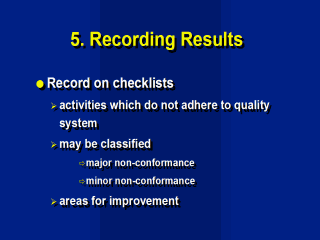| front |1 |2 |3 |4 |5 |6 |7 |8 |9 |10 |11 |12 |13 |14 |15 |16 |17 |18 |19 |20 |21 |22 |23 |24 |25 |26 |27 |28 |29 |30 |31 |32 |33 |34 |35 |36 |37 |38 |39 |40 |41 |review |
 |
During the
auditing process activities or documents will be identified which do not
strictly adhere to the quality management system. These discrepancies should
be recorded on the audit checklist with reference to the original documents.
Objective evidence must be identified.
A discrepancy in the system is called a non-conformance. These may be divided further to include: During the audit the auditor may identify duplication in the system or ways in which the system can be improved. These issues should be documented on the checklist and can be discussed with the auditee as areas for possible improvement. |